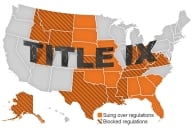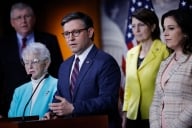You have /5 articles left.
Sign up for a free account or log in.
WASHINGTON -- Another legislative deadline for federal financial aid is looming in this town of perpetual crisis: the interest rate on subsidized student loans will double July 1, from 3.4 percent to 6.8 percent, if there is no Congressional action.
Last year, when loan rates were scheduled to double, President Obama seized on the issue in his re-election campaign, and Democrats and Republicans in Congress quickly agreed that the interest rate for subsidized loans (a need-based program under which the government pays the loan interest while students are enrolled in college) needed to be kept down. Student activists jumped into the argument, and Congress found a one-year fix to keep interest rates low at a cost of $6 billion.
This year, the situation seems different. A hearing Wednesday indicated that members of Congress from both parties are interested in thinking bigger when looking at the federal student loan programs -- either in a bill to avoid the interest rate hike for subsidized loans, or when the Higher Education Act is (eventually) renewed. The House Committee on Education and the Workforce hearing was billed as a broader look at changing the federal student loan programs, and few members of Congress chose to focus on the July 1 interest rate deadline in a wide-ranging discussion that lasted two hours.
The hearing was also the first concrete example of the influence the Bill & Melinda Gates Foundation’s project on redesigning financial aid (see related article) might have on Capitol Hill: Three of the four experts were from organizations that received grants to reimagine a financial aid system geared to college completion, and most of the proposals under discussion were recently put forward as part of that project.
Two of those proposals from witnesses at the hearing focused on setting the interest rates for student loans based on market rates. One recommendation, to set the interest rate at the 10-year Treasury borrowing rate plus 3 percent, was from Jason Delisle, director of the Federal Education Budget Project at the New America Foundation and originally included in the think tank’s report for the Gates project. Justin Draeger, president of the National Association of Student Financial Aid Administrators, also called for a “long-term, market-based solution” basing the rate from year to year on the cost of capital, servicing and loan counseling, and financial risk.
Unlike earlier hearings on direct lending, which often led to Republicans calling the program a government takeover and Democrats characterizing it as a boon for students, this one featured relatively few overt clashes between the parties, and few attacks on student aid.
Instead, the parties focused on different issues within the loan program -- Republicans were more concerned about interest rates and accounting, while Democrats wanted more protections for borrowers. (The exception was Scott DesJarlais, a Tennessee Republican, who suggested that loans were making students lazy and disinclined to work, and suggested shifting some Pell Grant money to federal work-study. “You’re poor in college, and that’s actually part of the fun of it,” DesJardins said, pointing out that he graduated from medical school in 1991 with more than $100,000 worth of loan debt.)
House Republicans in particular seemed to favor a switch toward an interest rate that can vary with market conditions. But the hearing’s focus quickly expanded, including the possibility of a switch to “fair value” accounting, which alters how the government accounts for risk in lending and makes student loans look less profitable for the federal government than they appear under current accounting rules. (Democrats pushed back against the proposal, as well as, in some cases, the premise that student loans should be profitable for the government at all.)
Senate Democrats, including Rep. George Miller, the committee’s ranking member, suggested they would favor additional loan counseling requirements. Draeger argued that colleges should be able to limit borrowing for students, perhaps those in specific majors and programs. On the Senate side, Senator Tom Harkin, chairman of the Appropriations Committee, introduced a bill Wednesday that would add new loan counseling requirements.
Groups that pushed to keep the interest rate at 3.4 percent didn’t like the focus of the hearing Wednesday, arguing that subsidized interest rates should stay low -- meaning the issue could still heat up between now and July 1.
“Last summer, Democrats and Republicans came together to prevent student loan interest rates from doubling, and this year, students can no more afford to have those rates double,” said Jen Mishory, deputy director of Young Invincibles, in a statement Wednesday, adding that the organization “is looking forward to working with all stakeholders to make sure this doesn’t happen, and that Congress takes long-term action to create a more effective and more affordable student loan system.”








